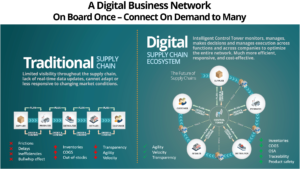
SJ: One Network is a digital supply chain platform. We provide digital twins that allow companies to do global demand-supply matching of their inventory, including in-transit inventory. We use predictive analytics and AI to detect and resolve issues and help companies really balance their supply chains and react to changes in demand and supply in real time.
TNB: And what about the company structure? Where are you based and how big is your team?
SJ: One Network is an American company headquartered in Dallas, Texas. The European region is headquartered in London. Globally we have about 500 staff, maybe even a little more than that as we’re growing quite rapidly.
Here in Europe we have a fairly small dedicated team of about 10 people working alongside team members from other parts of the organisation, plus partners. We will be growing our European team over the next 12 months.
TNB: What kind of customers do you work with?
SJ: In automotive our clients include OEMs and tier one automotive suppliers, but we also work with manufacturers and suppliers of consumer goods in the fast-moving FMCG sector, retail, health and life sciences, the public sector and defence.
TNB: In relation to automotive specifically, what does your work involve?
SJ: Most of what we do in automotive is on the inbound planning and execution of production parts and aftermarket parts into assembly/manufacturing plants. By execution I mean collaboration with suppliers and transport management. We also have customers who use One Network for the planning and distribution of aftermarket parts to their customers.
A big selling point for us in automotive is to be able to take a weekly order and create call-offs against that using the latest demand information and then do collaboration processes with the suppliers and logistics providers, and then tracking all the execution back into the plan including the transport processes with third party logistics. We also have customers who use One Network to create the forecast and the supply plans, or to plan and execute the transportation of parts across their network.
TNB: What are the advantages for your clients?
SJ: It’s about making everything more streamlined and integrated. Our technology helps our clients to respond in real time to what is actually happening without having to replace complex production scheduling tools.
We can identify when an order is going to be late for example, preventing manufacturers running just-in-time supply chains from either having to turn to expensive premium freight, or shut down the assembly line. Basically, we give earlier visibility and predictive analytics to keep the whole supply chain running smoothly.
TNB: Are we looking at a future where a driver loads something on to a vehicle and it’s recorded and tracked more instantly?
SJ: Funnily enough I’ve just been talking to an OEM on this exact topic, specifically around outbound vehicle distribution. They’re wondering how they can track where their finished vehicles are and be able to do instant demand-supply matching of the vehicle models that are being stored in hubs or are actually out on the road.
We’re now capturing more and more data, especially live real-time data from vehicle telematics and IoT (Internet of Things) devices. The more information we have, the better the visibility we’re able to provide, and the more efficient and effective the adjustments that can be made to the supply chain.
All of these technologies are really advancing at the moment. If you look forward to just a couple of years from now, the amount of data we’re going to be able to get from all parts of the supply chain is going to be even greater. We’re always looking at how we best capture that information and use it in an intelligent way.
TNB: Looking into your crystal ball, where are we going to be at with this kind of technology in five or 10 years’ time?
SJ: We’ve always talked about supply chain networks at an industry level and no one’s ever really been interested in it before. I think what’s started to happen with COVID – and what we’re going to see more of – is companies thinking about distribution beyond their own enterprise.
If you look at food for example, we’ll see more thought about how not just one company but a whole industry can network and collaborate to make sure what we have gets to where it needs to be. I think we’ll see a big shift towards companies thinking much more about wider networks rather than on any individual supply chain.
TNB: How is your technology helping customers navigate the COVID effect?
SJ: We’re actually doing a lot of in-transit inventory tracking for our customers already and we also do a lot of real-time capturing of demand and supply. As an example, one of our automotive customers was having to deal with all sorts of major impacts to its supply chain such as dealership closures and manufacturing plant shutdowns. They were able to adjust rapidly to what was happening by analysing our data from around the globe and using it to revise their plans.
We’re seeing a lot of those discussions with companies right now as they look to take what they did before and their chunky forecasts and throw them out of the window, and instead react in real-time to what’s happening right now.
Shirell James, Vice President Europe, One Network









